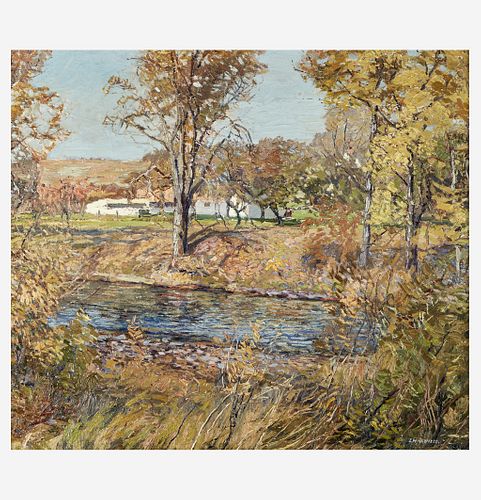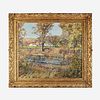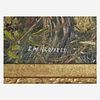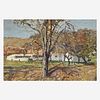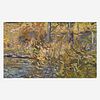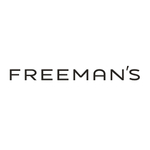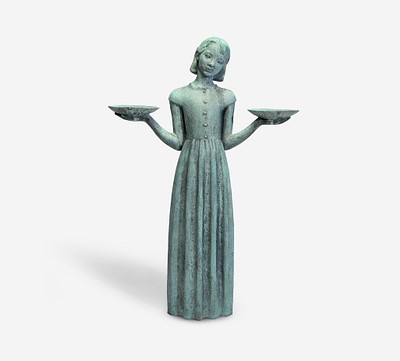Edward Willis Redfield (American, 1869–1965) Island Farm (The Artist's House)
About Seller
2400 Market St
Philadelphia, PA 19147
United States
Established in 1805, Freeman’s Auction House holds tradition close, with a progressive mind-set towards marketing and promotion, along with access to a team of top experts in the auction business. And now with offices in New England, the Southeast, and on the West Coast, it has never been easier to ...Read more
Two ways to bid:
- Leave a max absentee bid and the platform will bid on your behalf up to your maximum bid during the live auction.
- Bid live during the auction and your bids will be submitted real-time to the auctioneer.
Bid Increments
| Price | Bid Increment |
|---|---|
| $0 | $25 |
| $500 | $50 |
| $1,000 | $100 |
| $2,000 | $200 |
| $3,000 | $250 |
| $5,000 | $500 |
| $10,000 | $1,000 |
| $20,000 | $2,000 |
| $30,000 | $2,500 |
| $50,000 | $5,000 |
| $100,000 | $10,000 |
About Auction
Jun 6, 2021
Freeman’s is pleased to present Sylvia Shaw Judson’s Bird Girl, the highlight of the June 6 auction. In addition to the sculpture, this auction will also feature several notable works by significant American artists, including Daniel Garber, Norman Rockwell, Edward Redfield, and William Harnett. Freeman's info@freemansauction.com
- Lot Description
Edward Willis Redfield (American, 1869–1965) Island Farm (The Artist's House)
Signed 'E W REDFIELD' bottom right; also signed and titled on upper stretcher verso, oil on canvas
28 x 32 in. (71.1 x 81.3cm)
Executed circa 1910.Provenance
John H. Garzoli, San Francisco, California.
Acquired directly from the above circa 1995.
Private Collection, California.
Footnote:Literature
John M. W. Fletcher, Edward Willis Redfield 1869-1965, An American Impressionist: His Paintings and the Man Behind the Palette, Lahaska, Pennsylvania, 1996, p. 166, no. 336 (listed as Island Farm with the wrong dimensions, 23 x 32 in., not illustrated).
John M.W. Fletcher, Edward Willis Redfield, An American Impressionist 1869-1965: The Redfield Letters, Vol. II, Lahaska, Pennsylvania, 2002, no. 218, p. 397 (illustrated as Along the Delaware Canal).Note
The present work will be included in the forthcoming Catalogue Raisonné of Edward Redfield's work, compiled by Dr. Thomas C. Folk.
In the summer of 1898, Edward Redfield and his wife moved from Glenside, Pennsylvania to the rural village of Centre Bridge, just five miles north of New Hope. There, the Redfields bought a 127-acre strip of land beside the two path of the canal, overlooking the beautiful Delaware River. The farm, formerly used as a stable for mules, was situated on an island, in between the river bank and the canal. It is this house, the artist's first, that the present painting depicts. Redfield and his family stayed in the house until 1931, and it remained an important source of inspiration for the artist, who painted it several times in all four seasons, as exemplified by December, which shows the farm covered in snow, sitting tranquil by the frozen river.
Redfield chose the house “not for the beauty of the countryside, but because this was a place where an independent, self-sufficient man could make a living from the land, bring up a family and still have the freedom to paint as he saw fit.” The relocation fitted Redfield's vision of manhood, mostly channeled by Henry David Thoreau, and yearning for a life of hard work and complete harmony with nature. In fact, Redfield was no different than most city dwellers who, in time of economic crises, traded life in a big, fuming city for a simpler, more peaceful existence in the back country. Redfield's house was furnished chiefly from the nearby driftwood and seasoned timber, and which he used to make tables, chairs and chests. As journalist Walter Dyer put it in a 1907 article specifically devoted to Redfield's presence in Centre Bridge, Redfield "made a dry and comfortable house of it, if not an elegant one." He concluded by giving credit to Redfield, ackowledging the simple way of life in the countryside provided an ideal environment for the full and authentic expression of one's self: "The Country called them and they went forth not knowing what the outcome would be. They have blazed the trail for those who follow. They have taught us one more lesson in the gospel of the simple life."
Redfield's life in the country strenghtened his character (each season was a new battle against the elements to keep the house in shape), but also deepened his respect for nature. In the present work, the house is barely noticeable: it is in complete harmony with its sourroundings, camouflaged behind the colorful leaves and vines of a full and lush autumn. It mirrors Redfield's attitude towards nature: secluded, fully immersed and waiting to be noticed.
Condition report:The relined canvas in excellent original condition, with no sign of inpainting as seen under UV light. The work must have been selectively cleaned as we can spot some remnants of old greenish varnish in some areas. See Specialist's pictures for more details.
Frame: 37 1/2 x 41 1/2 x 3 in.
- Shipping Info
-
No lot may be removed from Freeman’s premises until the buyer has paid in full the purchase price therefor including Buyer’s Premium or has satisfied such terms that Freeman’s, in its sole discretion, shall require. Subject to the foregoing, all Property shall be paid for and removed by the buyer at his/ her expense within ten (10) days of sale and, if not so removed, may be sold by Freeman’s, or sent by Freeman’s to a third-party storage facility, at the sole risk and charge of the buyer(s), and Freeman’s may prohibit the buyer from participating, directly or indirectly, as a bidder or buyer in any future sale or sales. In addition to other remedies available to Freeman’s by law, Freeman’s reserves the right to impose a late charge of 1.5% per month of the total purchase price on any balance remaining ten (10) days after the day of sale. If Property is not removed by the buyer within ten (10) days, a handling charge of 2% of the total purchase price per month from the tenth day after the sale until removal by the buyer shall be payable to Freeman’s by the buyer. Freeman’s will not be responsible for any loss, damage, theft, or otherwise responsible for any goods left in Freeman’s possession after ten (10) days. If the foregoing conditions or any applicable provisions of law are not complied with, in addition to other remedies available to Freeman’s and the Consignor (including without limitation the right to hold the buyer(s) liable for the bid price) Freeman’s, at its option, may either cancel the sale, retaining as liquidated damages all payments made by the buyer(s), or resell the property. In such event, the buyer(s) shall remain liable for any deficiency in the original purchase price and will also be responsible for all costs, including warehousing, the expense of the ultimate sale, and Freeman’s commission at its regular rates together with all related and incidental charges, including legal fees. Payment is a precondition to removal. Payment shall be by cash, certified check or similar bank draft, or any other method approved by Freeman’s. Checks will not be deemed to constitute payment until cleared. Any exceptions must be made upon Freeman’s written approval of credit prior to sale. In addition, a defaulting buyer will be deemed to have granted and assigned to Freeman’s, a continuing security interest of first priority in any property or money of, or owing to such buyer in Freeman’ possession, and Freeman’s may retain and apply such property or money as collateral security for the obligations due to Freeman’s. Freeman’s shall have all of the rights accorded a secured party under the Pennsylvania Uniform Commercial Code.
-
- Buyer's Premium



 EUR
EUR CAD
CAD AUD
AUD GBP
GBP MXN
MXN HKD
HKD CNY
CNY MYR
MYR SEK
SEK SGD
SGD CHF
CHF THB
THB